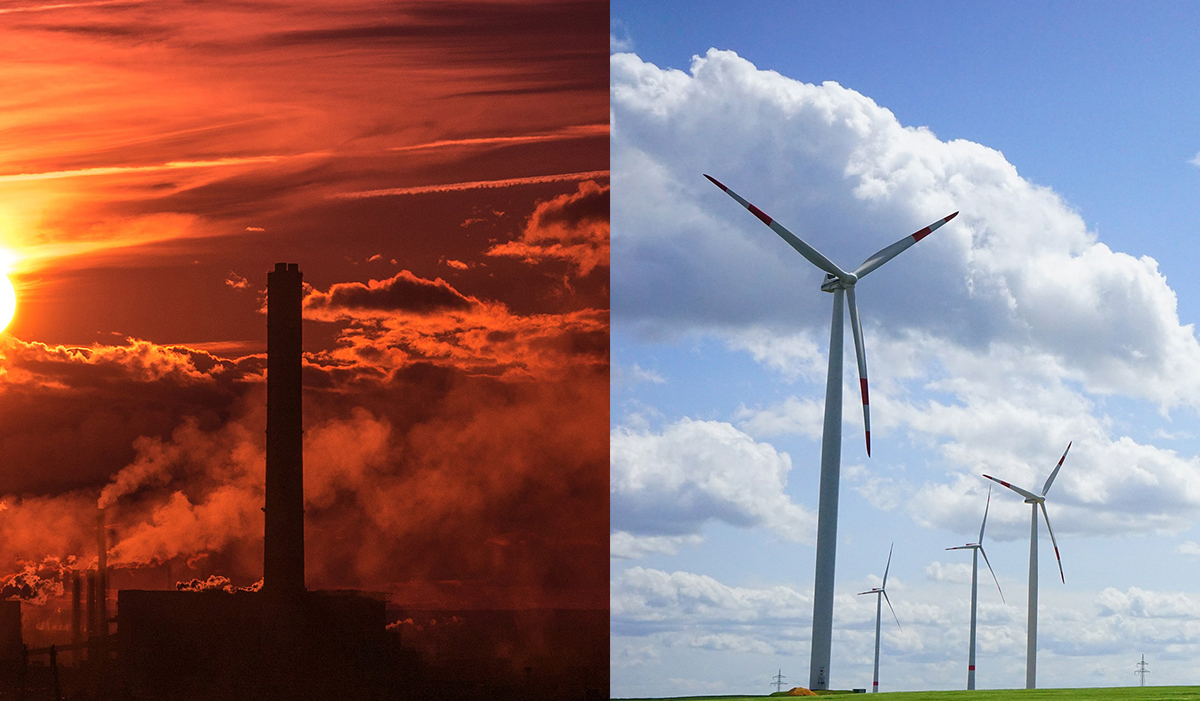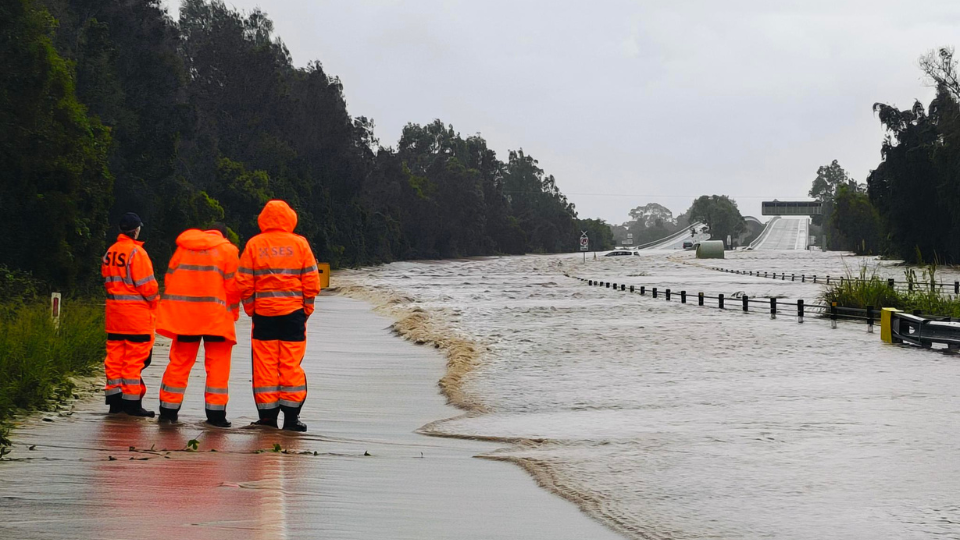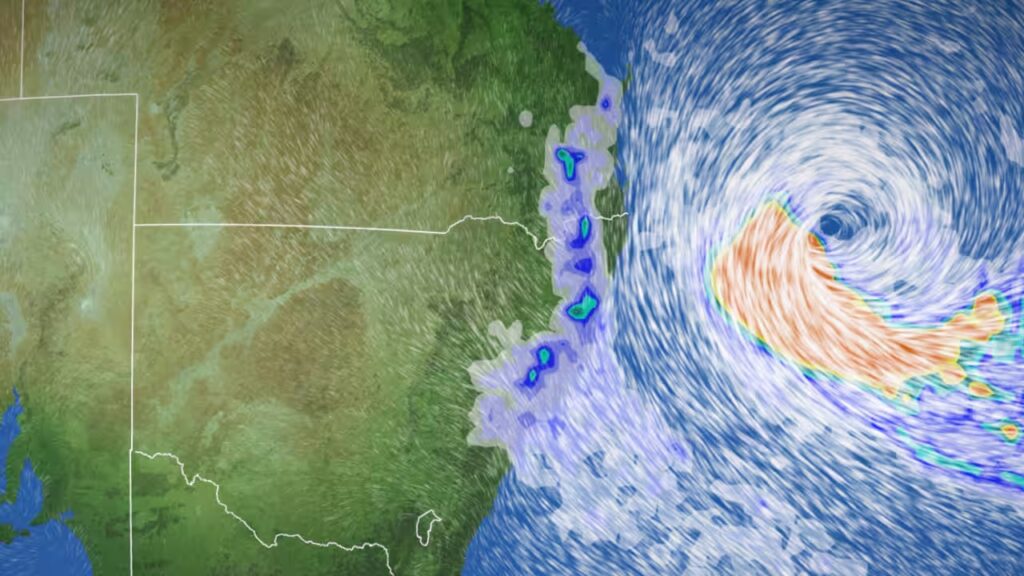Climate science can be complex, and misinformation in politics and the media can make it difficult to sort fact from fiction. Here, we’ve answered eight common climate change questions, including what’s causing climate change, what scientists are saying and what we can do about it. Read on to get up to speed!
2. What is causing climate change?
3. How is climate change affecting Australia?
4. Why do only a few degrees of warming matter?
5. How do scientists know the climate is changing?
6. What are the main sources of greenhouse gas emissions in Australia?
7. What can Australia do to combat climate change?
8. How does Australia measure up on the world stage?
1. What is climate change?
Climate is different from weather. When we talk about the Earth’s climate, we are referring to the average weather conditions over a period of 30 years or longer. Weather, on the other hand, refers to what you see and feel outside from day to day (e.g. sunny, rainy).
So climate change is any change in the climate, lasting for several decades or longer, including changes in temperature, rainfall or wind patterns.
The best scientific evidence we have shows that our world is rapidly heating.
Long-term air and ocean temperature records clearly show the Earth is warming. The global average temperature has already risen by 1.1°C since the time before the Industrial Revolution. This might not sound like a lot, but 1.1°C represents a massive amount of extra heat and energy – the equivalent of four Hiroshima bomb detonations per second.
While the earth’s climate has changed throughout history, scientists agree that the significant changes we’ve seen over the past hundred years or so have been due to human activities. Recent warming is also happening at a rate that is much faster than previous climatic changes.
Temperature Anomalies by Country 1880-2017 based on NASA GISTEMP data. By Antti Lipponen.
2. What is causing climate change?
The short answer is: the excessive amount of greenhouse gases entering the Earth’s atmosphere due to human activity is causing our climate to heat dramatically. But there’s more to it than that.
Let’s break it down. A certain amount of greenhouse gases (like water vapour, ozone, carbon dioxide, methane and nitrous dioxide) occur naturally. For example, carbon dioxide is produced through the respiration of natural ecosystems (plants), or through the decay of organic matter (biomass). These greenhouse gases act like a blanket in our atmosphere, trapping some of the sun’s heat close to the Earth’s surface. This is known as the ‘greenhouse effect’ – and it makes the planet warm enough for us to live.
But since the Industrial Revolution (which began in the mid to late 1700s), greenhouse gases have built up in the atmosphere, leading to more heat being trapped close to the earth’s surface. This is because Western civilisations began digging up and burning coal, oil and gas on a massive scale. At the same time, agriculture, tree-clearing (deforestation) and the production of waste (landfill) also increased. All of these processes also produce greenhouse gases.
As more greenhouse gases are added to the Earth’s atmosphere, more of the sun’s heat is trapped. This causes the Earth’s average temperature to rise.
Carbon dioxide is the most significant of all the greenhouse gases, followed by methane. Carbon dioxide levels in the atmosphere have increased by more than 45% since the Industrial Revolution and are now the highest they have been for at least 800,000 years.
3. How is climate change affecting Australia?
Australia is one of the most vulnerable developed countries in the world to the impacts of climate change. These include:
- Increased frequency and/or severity of extreme weather events including floods and droughts. Read more here.
- More frequent, more intense and longer-lasting heatwaves. Heatwaves are deadly, having killed more people than all other extreme weather events in Australia combined. Read more here.
- Greater risk and severity of bushfires and earlier, longer bushfire seasons. Read more here.
- Sea level rise, leading to more coastal flooding, erosion and saltwater intrusion into freshwater wetlands, such as in the World-Heritage listed Kakadu National Park. Low-lying properties near rivers and coastlines are also at risk posing significant threats to commercial, industrial, road, rail, and residential assets. Read more here.
- Impacts on wildlife due to heat stress, drought and habitat changes, which have flow-on effects down the food chain. Australia holds the first record of a mammalian extinction due to climate change. Read more here.
- More frequent marine heatwaves, which impact marine ecosystems such as the Great Barrier Reef. After the back-to-back marine heatwaves in 2016 and 2017, 50% of the coral on the Great Barrier Reef died. Mass bleaching occurred again in 2020. Read more here.
- Impacts on health due to changes in air pollution and air-borne allergens (such as pollen), vector-borne diseases, extreme weather events and other factors. Read more here.
- Increased pressure on emergency services and health systems, as the fire seasons of states and territories increasingly overlap which stretches resources, and the health impacts of climate change worsen. Read more here.
- Agricultural impacts from more frequent droughts, floods and heatwaves. Read more here.
We are already experiencing these impacts today, at a rise in temperature of just 1.1 ̊C since the pre-industrial period. In recent times, Australia has been rocked by the Black Summer of 2019-2020 characterised by catastrophic bushfires, unprecedented in their scale and harm; has seen devastating floods in Townsville; and a fierce drought which threatened the food and water security of Australians for many years.
The risks to our wellbeing and livelihoods, and to other species and ecosystems, become much more profound as temperatures continue to rise.
Read more about droughts, bushfires and other extreme weather events in Australia here.
4. Why do only a few degrees of warming matter?
A few degrees of warming is incredibly significant.
The work of the Intergovernmental Panel on Climate Change (IPCC) shows the dire consequences we face if we fail to limit the global temperature increase to 1.5°C. Even at 1.1°C of global warming, how much the global temperature has increased by so far, the impacts we have seen from a changing climate have been intolerable. Lives, livelihoods and homes have been unnecessarily destroyed and communities are under constant pressure. It is essential that we do our best to hold global temperatures as low as possible, as shown in the following infographic.
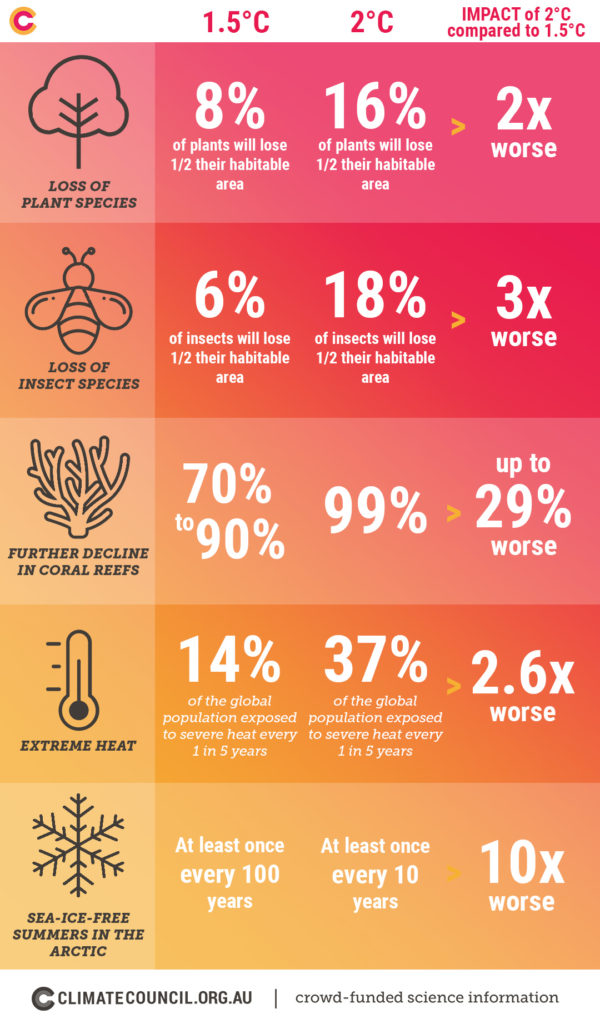
Adapted from WRI (07/10/18) based on data from IPCC (10/2018).
To avoid the impacts we’d experience at 2 degrees warming, we have no other choice but to limit our warming as close to 1.5 ̊C as possible.
If nothing changes, we could be on track for a rise in temperatures of between 4-6 ̊C. To put this in context, the difference in temperatures between now and the last ice age was around 4 ̊C.
The Paris Agreement is a global treaty agreed to by over 190 countries around the world. In this agreement, the global community committed to limit global warming to well below 2°C and to pursue efforts to limit warming to 1.5 ̊C. It is an important step towards addressing the global challenge of climate change. But with the current pledges that countries have put forward, the world is on track for at least 3.2 ̊C of warming by the end of the century.
5. How do scientists know the climate is changing?
Scientists collect data about the climate by testing a number of things: air and ocean temperature, precipitation, sea level, ocean salinity and acidity, tree rings, marine sediments, and pollen, to name a few.
Ice cores from Antarctica are incredibly helpful in showing how the climate has changed over time, because they can provide a record of what the level of greenhouse gases such as carbon dioxide and methane were in our atmosphere in the past, as well as providing clues about past temperatures. Ice core data stretches back 800,000 years and shows that the concentration of greenhouse gases in our atmosphere over this period has never increased so quickly, or by so much, as it has during recent times.
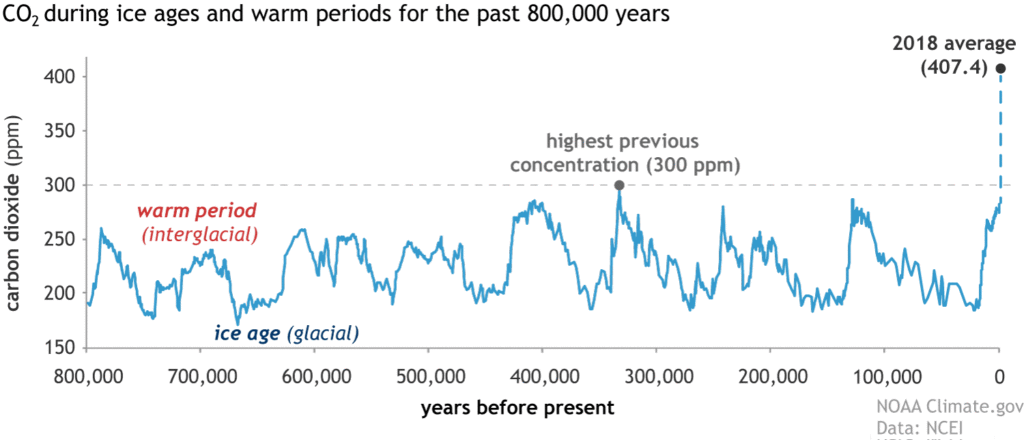
Carbon dioxide levels in the atmosphere over the past 800,000 years, based off data from ice cores. C02 levels have never been as high as they are now. Source: NOAA
Pulling all of this data together, scientists have concluded that humans have been driving the significant changes in climate that we are currently experiencing. The evidence that supports anthropogenic (human-caused) climate change is vast and includes many lines of evidence published in tens of thousands of peer-reviewed journal articles.
6. What are the main sources of greenhouse gas emissions in Australia?
There are eight major areas (sectors) in Australia responsible for our greenhouse gas emissions:
- Electricity (emissions from burning coal and gas to power our lights, appliances and more)
- Transport (emissions from petrol and diesel used to power cars, trucks and buses, and emissions from aviation fuel used to power planes)
- Stationary energy (fuels like gas consumed directly, rather than used for electricity, in industry and in households)
- Agriculture (greenhouse gases such as methane and nitrous oxide produced by animals, manure management, fertilisers and field burning)
- Fugitive emissions (gases vented from fossil fuel extraction and transportation)
- Industrial processes (emissions produced by converting raw materials into metal, mineral and chemical products)
- Waste (emissions from decaying organic matter)
- Land use, land use change and forestry (LULUCF) (emissions and removals mainly from forests, but also from croplands, grasslands, wetlands and other lands).
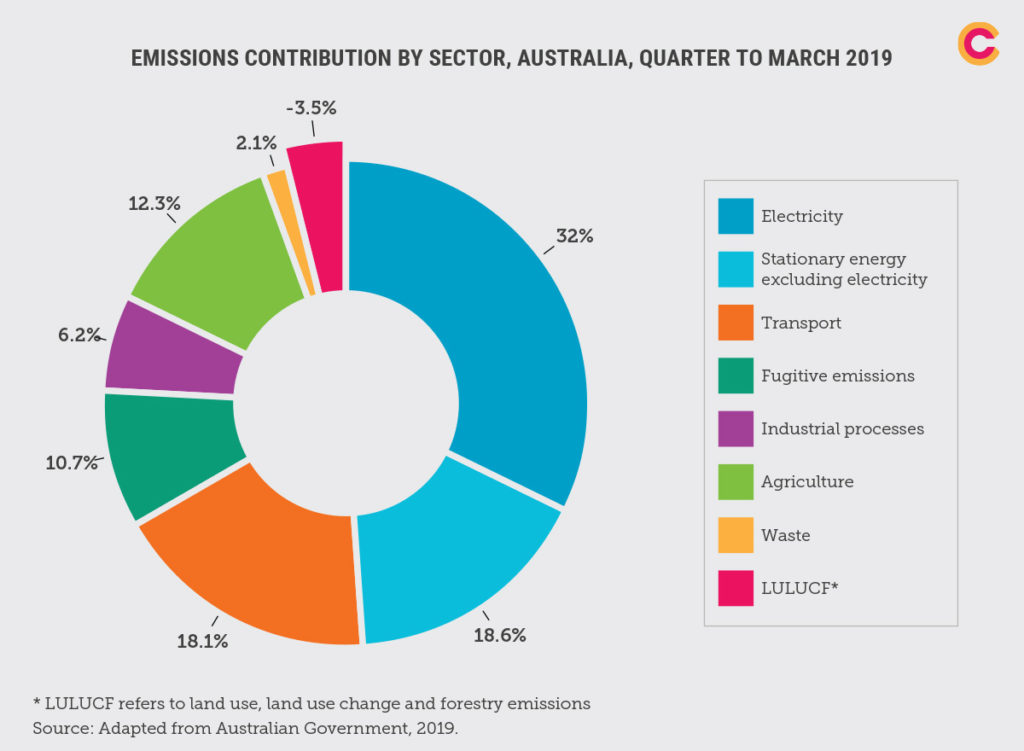
Australia’s greenhouse gas emissions by sector, 2019. Electricity remains the biggest contributor of greenhouse gases in Australia. Source: March 2019 quarterly updates.
Electricity is the largest source of greenhouse gas emissions in Australia, responsible for 32% of emissions. This is mainly because 84% of our electricity comes from burning fossil fuels, the large majority of this (59.9%) is from burning coal.
Fortunately, Australia is the sunniest and one of the windiest countries in the world, which means we are perfectly placed to generate our electricity from renewable energy sources, like solar and wind.
Updating Australia’s energy system with renewables and storage is crucial for cutting our greenhouse gas emissions and combating climate change.
7. What can Australia do to combat climate change?
Although we are already experiencing the consequences of climate change today, we also have the solutions to address it.
Australia urgently needs to reduce its greenhouse gas emissions as part of a strong global effort.
In 2018, the IPCC concluded that the world must cut emissions to net zero by no later than 2050 to have a chance of limiting warming to 1.5 ̊C. This meant that global carbon dioxide emissions would need to be roughly halved by 2030. Since 2018 our understanding has grown still further, and it is now clear that even faster action is necessary to meet the goals of the Paris Agreement. Put simply, emissions need to plummet this decade and reach net zero by 2040 at latest.
Here are the easiest, most efficient and cost-effective ways for Australia to reduce its greenhouse gas emissions:
- Electricity
Rapidly transitioning away from fossil fuel generated electricity to renewable energy and storage technologies is the quickest and cheapest way to reduce emissions. In Australia and many other countries, new renewable energy is now cheaper than new coal and global investment in coal has plummeted by 75% in three years. - Transport
Avoiding dangerous climate change doesn’t start and end with changing electricity. We also need to electrify our transport systems – like buses, cars, trains and trams – and power them with 100% renewable electricity too. Transport makes up around 19% of Australia’s greenhouse gas emissions, but these emissions can be reduced by: improving public transport’s quality, efficiency and accessibility, encouraging active transport (such as cycling and walking), and building infrastructure (like vehicle charging stations), to encourage people to use electric vehicles. - Agriculture
Agriculture contributes roughly 13% of Australia’s emissions, and deforestation accounts for around 9% of Australia’s emissions. But climate solutions like reforestation and regenerative agriculture can increase how much carbon is stored in soils and vegetation, removing carbon dioxide from the atmosphere. - Fossil fuels
Australia needs to actively transition away from fossil fuels like coal, oil and gas, including those we export. As the second largest exporter of both thermal coal (which is burned to generate electricity) and gas, Australia has a huge influence on global emissions and the fossil fuel market. If we include all the fossil fuels that Australia exports, Australia is the fifth biggest polluter in the world – so we’re a big deal when it comes to climate change.Australia should not approve any new fossil fuel projects, and must actively phase out existing projects to reduce emissions. This process has to support fossil fuel-dependent communities and workers – and make sure that they have opportunities to move into other industries.
8. How does Australia measure up on the world stage?
Australia is a very big deal on the world stage when it comes to causing climate change.
In 2019, Australia was the worlds’ largest liquefied fossil gas exporter, the world’s second largest coal exporter.
Combined with our very high emissions at home, Australia packs a big punch to the global climate. Even ignoring its exported fossil fuels, Australia is the 14th biggest greenhouse polluter in the world. There are 195 countries signed up to the Paris Agreement. More than 180 countries of them emit less than Australia per year, and this list includes several of the world’s largest economies, and many countries with far larger populations. This includes the birthplace of the Industrial Revolution: the United Kingdom.
Alongside all of this, Australia has routinely played a key role in hobbling international climate negotiations over the entire life of international climate diplomacy, and this continues right up until today.
This is all important because, while the whole world needs to meet a net zero goal by 2050, countries like Australia, that have been major causes of our supercharged global climate, must reduce far sooner if there is any hope of achieving globally agreed temperature goals.
For this goal to be achievable, Australia must drive down all emissions, across all sectors now.
Current levels of Government inaction on climate change cannot continue. There is no more time for piecemeal and token efforts to reduce emissions on one hand while at the same time overseeing drastic increases elsewhere.
9. Where can I find out more?
The Climate Council has created a range of science-backed materials to further explain the causes, impacts and solutions to climate change. Take a look at our Reports, Videos and Infographics.
These might also interest you:
What can YOU do to tackle climate change?
Watt’s watt? A guide to renewable energy capacity and generation
Climate Action: 6 reasons to feel inspired not defeated
Let’s Get Something Straight – Australia Is Not On Track To Meet Its Paris Climate Target

